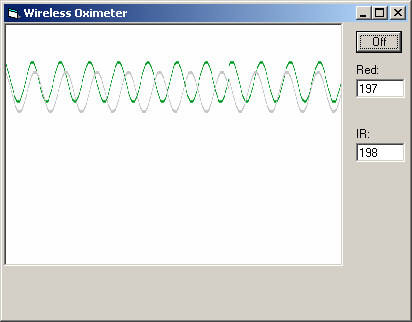
Devre kablosuz olarak kandaki oksijenin miktarını ölçüyor kontrol entegresi pic16f876 bilgisayar bağlantısı usb paralel modül ile sağlanmış tüm detaylar (ingilizce) akış diağramları kaynak picc ve pc yazılımı paylaşılmış
Kablosuz Oksimetre Tıp alanı, kablosuz teknolojiyi hızla benimsiyor. Bir dizi hastayı uzaktan izleyebilmenin avantajları açıktır ve yoğun bir hastanede verimliliğin artmasına yol açar.
Oksimetre uygulaması Oksimetre, her biri parmak klipsinin bir “katmanı” olarak tasarlanan iki PCB’ye ayrıldı. LED’ler üst PCB’ye yerleştirilirken, bileşenlerin geri kalanı yer kazanmak için çift taraflı olarak alt PCB’ye yerleştirildi. Bu PCB’lerin her ikisinin de tasarımı şurada bulunabilir:
QTLP650C-7, bir dalga boyunda yayan yüzeye monte AlGaAs kırmızı LED 660nm, yüzeye monte bir IR LED olan HSDL-4400-011 ile birlikte kullanıldı,
910nm dalga boyunda yayar. Tipik yoğunlukları 20 ve 15mcd’dir. sırasıyla 20mA’da. Bir BPW17N fototransistör ve TL072 op amp IC kullanıldı ilave olarak. Oksimetreye güç sağlamak için iki adet CR2032DP2 3V lityum madeni para pil, her biri 180mAh kapasite kullanılmıştır.
Seçilen alıcı-verici, RFWaves’in antenli RFW102-M modülüydü. ISM’de çalışan kısa menzilli, yarı çift yönlü kablosuz alıcı-verici (2400- 2483.5MHz) bandı. 1 Mbps’ye kadar veri aktarımını ve çok düşük gücü destekler veri hızıyla orantılı tüketim (tipik olarak 1Mbps’de 21mA, 1kbps’de 28mA).
Oksimetre sabit yazılımı Hem oksimetre hem de alıcı için seçilen mikrodenetleyici, nispeten küçük boyutu ve kullanım kolaylığı nedeniyle PIC16F876 idi. 10 bitlik, 8 kanal ADC, düşük besleme voltajı, düşük güç tüketimi ve 28 pinli olarak gelir
Wireless Oximeter The medical field has been quick to embrace wireless technology. The advantages in being able to monitor a number of patients from a distance are obvious, and lead to improved efficiency in a busy hospital.
Oximeter implementation The oximeter was separated into two PCBs, each intended for a ‘layer’ of the finger clip. The LEDs were positioned on the top PCB, while the rest of the components were on the bottom PCB, double-sided to save room. The design of both these PCBs can be found in
The QTLP650C-7, a surface mount AlGaAs red LED, which emits at a wavelength of
660nm, was used in conjunction with the HSDL-4400-011, a surface mount IR LED,
which emits at a wavelength of 910nm. They have a typical intensity of 20 and 15mcd
at 20mA, respectively. A BPW17N phototransistor and TL072 op amp IC were used
as well. To power the oximeter, two CR2032DP2 3V lithium coin cells, each with a
capacity of 180mAh, were used.The transceiver chosen was the RFW102-M module with antenna, from RFWaves, a
short-range, half duplex wireless radio transceiver, which functions in the ISM (2400-
2483.5MHz) band. It supports data transfer up to 1Mbps, and very low power
consumption, proportional to the data rate (typically 21mA at 1Mbps, 28mA at 1kbps).Oximeter firmware The microcontroller chosen for both the oximeter and the receiver was the PIC16F876, because of its relatively small size and ease of use. It features a 10-bit, 8
channel ADC, low supply voltage, low power consumption, and comes in a 28-pin
DIP package.
Dosya ve detaylar: innovexpo.itee.uq.edu.au/2003/exhibits/s363328/
Şifre-Pass: 320volt.com
Yayım tarihi: 2009/12/24 Etiketler: elektronik kan ölçümü, medikal devre, microchip pic projeleri, oximeter, PIC16F876 örnekleri, tıp elektronigi, usb

